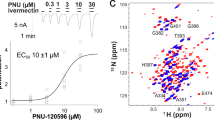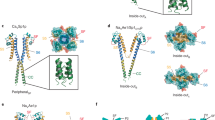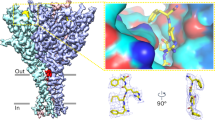Abstract
Pentameric ligand-gated ion channels (pLGICs) are key players in the early events of electrical signal transduction at chemical synapses. The family codes for a structurally conserved scaffold of channel proteins that open in response to the binding of neurotransmitter molecules. All proteins share a pentameric organization of identical or related subunits that consist of an extracellular ligand-binding domain followed by a transmembrane channel domain. The nicotinic acetylcholine receptor (nAChR) is the most thoroughly studied member of the pLGIC family (for recent reviews see refs 1–3). Two sources of structural information provided an architectural framework for the family. The structure of the soluble acetylcholine-binding protein (AChBP) defined the organization of the extracellular domain and revealed the chemical basis of ligand interaction4,5,6. Electron microscopy studies of the nAChR from Torpedo electric ray have yielded a picture of the full-length protein and have recently led to the interpretation of an electron density map at 4.0 Å resolution7,8,9. Despite the wealth of experimental information, high-resolution structures of any family member have so far not been available. Until recently, the pLGICs were believed to be only expressed in multicellular eukaryotic organisms. The abundance of prokaryotic genome sequences, however, allowed the identification of several homologous proteins in bacterial sources10,11. Here we present the X-ray structure of a prokaryotic pLGIC from the bacterium Erwinia chrysanthemi (ELIC) at 3.3 Å resolution. Our study reveals the first structure of a pLGIC at high resolution and provides an important model system for the investigation of the general mechanisms of ion permeation and gating within the family.
This is a preview of subscription content, access via your institution
Access options
Subscribe to this journal
Receive 51 print issues and online access
$199.00 per year
only $3.90 per issue
Buy this article
- Purchase on Springer Link
- Instant access to full article PDF
Prices may be subject to local taxes which are calculated during checkout




Similar content being viewed by others
Accession codes
References
Karlin, A. Emerging structure of the nicotinic acetylcholine receptors. Nature Rev. Neurosci. 3, 102–114 (2002)
Lester, H. A., Dibas, M. I., Dahan, D. S., Leite, J. F. & Dougherty, D. A. Cys-loop receptors: new twists and turns. Trends Neurosci. 27, 329–336 (2004)
Sine, S. M. & Engel, A. G. Recent advances in Cys-loop receptor structure and function. Nature 440, 448–455 (2006)
Brejc, K. et al. Crystal structure of an ACh-binding protein reveals the ligand-binding domain of nicotinic receptors. Nature 411, 269–276 (2001)
Celie, P. H. et al. Nicotine and carbamylcholine binding to nicotinic acetylcholine receptors as studied in AChBP crystal structures. Neuron 41, 907–914 (2004)
Hansen, S. B. et al. Structures of Aplysia AChBP complexes with nicotinic agonists and antagonists reveal distinctive binding interfaces and conformations. EMBO J. 24, 3635–3646 (2005)
Unwin, N. Structure and action of the nicotinic acetylcholine receptor explored by electron microscopy. FEBS Lett. 555, 91–95 (2003)
Miyazawa, A., Fujiyoshi, Y. & Unwin, N. Structure and gating mechanism of the acetylcholine receptor pore. Nature 423, 949–955 (2003)
Unwin, N. Refined structure of the nicotinic acetylcholine receptor at 4 Å resolution. J. Mol. Biol. 346, 967–989 (2005)
Tasneem, A., Iyer, L. M., Jakobsson, E. & Aravind, L. Identification of the prokaryotic ligand-gated ion channels and their implications for the mechanisms and origins of animal Cys-loop ion channels. Genome Biol. 6, R4 (2005)
Bocquet, N. et al. A prokaryotic proton-gated ion channel from the nicotinic acetylcholine receptor family. Nature 445, 116–119 (2007)
Adams, D. J., Dwyer, T. M. & Hille, B. The permeability of endplate channels to monovalent and divalent metal cations. J. Gen. Physiol. 75, 493–510 (1980)
Gallivan, J. P. & Dougherty, D. A. Cation–pi interactions in structural biology. Proc. Natl Acad. Sci. USA 96, 9459–9464 (1999)
Purohit, P., Mitra, A. & Auerbach, A. A stepwise mechanism for acetylcholine receptor channel gating. Nature 446, 930–933 (2007)
Campos-Caro, A. et al. A single residue in the M2–M3 loop is a major determinant of coupling between binding and gating in neuronal nicotinic receptors. Proc. Natl Acad. Sci. USA 93, 6118–6123 (1996)
Grosman, C., Salamone, F. N., Sine, S. M. & Auerbach, A. The extracellular linker of muscle acetylcholine receptor channels is a gating control element. J. Gen. Physiol. 116, 327–340 (2000)
Kash, T. L., Jenkins, A., Kelley, J. C., Trudell, J. R. & Harrison, N. L. Coupling of agonist binding to channel gating in the GABAA receptor. Nature 421, 272–275 (2003)
Zhou, Y., Morais-Cabral, J. H., Kaufman, A. & MacKinnon, R. Chemistry of ion coordination and hydration revealed by a K+ channel–Fab complex at 2.0 Å resolution. Nature 414, 43–48 (2001)
Dutzler, R., Campbell, E. B. & MacKinnon, R. Gating the selectivity filter in ClC chloride channels. Science 300, 108–112 (2003)
Wilson, G. & Karlin, A. Acetylcholine receptor channel structure in the resting, open, and desensitized states probed with the substituted-cysteine-accessibility method. Proc. Natl Acad. Sci. USA 98, 1241–1248 (2001)
Paas, Y. et al. Pore conformations and gating mechanism of a Cys-loop receptor. Proc. Natl Acad. Sci. USA 102, 15877–15882 (2005)
Le Novere, N. & Changeux, J. P. LGICdb: the ligand-gated ion channel database. Nucleic Acids Res. 29, 294–295 (2001)
Konno, T. et al. Rings of anionic amino acids as structural determinants of ion selectivity in the acetylcholine receptor channel. Proc R. Soc. Lond. B 244, 69–79 (1991)
Cohen, B. N., Labarca, C., Davidson, N. & Lester, H. A. Mutations in M2 alter the selectivity of the mouse nicotinic acetylcholine receptor for organic and alkali metal cations. J. Gen. Physiol. 100, 373–400 (1992)
Corringer, P. J. et al. Mutational analysis of the charge selectivity filter of the alpha7 nicotinic acetylcholine receptor. Neuron 22, 831–843 (1999)
Gunthorpe, M. J. & Lummis, S. C. Conversion of the ion selectivity of the 5-HT(3a) receptor from cationic to anionic reveals a conserved feature of the ligand-gated ion channel superfamily. J. Biol. Chem. 276, 10977–10983 (2001)
Imoto, K. et al. Rings of negatively charged amino acids determine the acetylcholine receptor channel conductance. Nature 335, 645–648 (1988)
Revah, F. et al. Mutations in the channel domain alter desensitization of a neuronal nicotinic receptor. Nature 353, 846–849 (1991)
Beckstein, O. & Sansom, M. S. A hydrophobic gate in an ion channel: the closed state of the nicotinic acetylcholine receptor. Phys. Biol. 3, 147–159 (2006)
Cymes, G. D., Ni, Y. & Grosman, C. Probing ion-channel pores one proton at a time. Nature 438, 975–980 (2005)
Kabsch, W. Automatic processing of rotation diffraction data from crystals of initially unknown symmetry and cell constants. J. Appl. Cryst. 26, 795–800 (1993)
Collaborative Computational Project, Number 4. The CCP4 suite: programs for X-ray crystallography. Acta Crystallogr. D 50, 760–763 (1994)
Pape, T. & Schneider, T. R. HKL2MAP: a graphical user interface for phasing with SHELX programs. J. Appl. Cryst. 37, 843–844 (2004)
Schneider, T. R. & Sheldrick, G. M. Substructure solution with SHELXD. Acta Crystallogr. D 58, 1772–1779 (2002)
de La Fortelle, E. & Bricogne, G. in Methods in Enzymology (eds Carter, C. W. & Sweet, R. M.) 492–494 (Academic, New York, 1997)
Cowtan, K. An automated procedure for phase improvement by density modification. Joint CCP4 ESF-EACBM Newslett. Protein Crystallogr. 31, 34–38 (1994)
Jones, T. A., Zou, J. Y., Cowan, S. W. & Kjeldgaard, M. Improved methods for building protein models in electron density maps and the location of errors in these models. Acta Crystallogr. A 47, 110–119 (1991)
Brunger, A. T. et al. Crystallography & NMR system: a new software suite for macromolecular structure determination. Acta Crystallogr. D 54, 905–921 (1998)
Smart, O. S., Neduvelil, J. G., Wang, X., Wallace, B. A. & Sansom, M. S. HOLE: a program for the analysis of the pore dimensions of ion channel structural models. 14, 354–360. J. Mol. Graph. 14, 354–360, 376 (1996)
Sanner, M. F., Olson, A. J. & Spehner, J. C. Reduced surface: an efficient way to compute molecular surfaces. Biopolymers 38, 305–320 (1996)
Nimigean, C. M. & Miller, C. Na+ block and permeation in a K+ channel of known structure. J. Gen. Physiol. 120, 323–335 (2002)
Brooks, B. R. et al. CHARMM: a program for macromolecular energy, minimization, and dynamics calculations. J. Comput. Chem. 4, 187–217 (1983)
Im, W., Beglov, D. & Roux, B. Continuum salvation model: electrostatic forces from numerical solutions to the Poisson–Bolztmann equation. Comput. Phys. Commun. 111, 59–75 (1998)
Acknowledgements
We thank I. Toth from the Scottish Crop Research Institute for providing g-DNA of E. chrysanthemi, B. Blattmann and A. Haisch for assistance with crystal screening, D. Sargent for help with Xe derivatization, C. Schulze-Briese and the staff of the X06SA beamline for support during data collection, the Protein Analysis Group at the Functional Genomics Center of the University of Zürich for help with mass spectrometry, R. MacKinnon for comments on the manuscript and members of the Dutzler laboratory for help in all stages of the project. Data collection was performed at the Swiss Light Source of the Paul Scherrer Institute. This work was supported by a grant from the National Center for Competence in Research in Structural Biology and the EMBO Young Investigator Program to R.D. R.J.C.H. is affiliated with the Molecular Life Sciences Ph.D. Program of the University/ETH Zürich.
Author Contributions R.D. and R.J.C.H. designed the project. R.J.C.H. performed all experiments. R.D. assisted in data collection, structure determination and electrostatic calculations. R.D. and R.J.C.H. jointly wrote the manuscript.
Author information
Authors and Affiliations
Corresponding author
Additional information
Coordinates have been deposited in the Protein Data Bank under code 2vl0.
Supplementary information
Supplementary Information
The file contains Supplementary Figures S1-S7 with Legends. (PDF 2638 kb)
Rights and permissions
About this article
Cite this article
Hilf, R., Dutzler, R. X-ray structure of a prokaryotic pentameric ligand-gated ion channel. Nature 452, 375–379 (2008). https://doi.org/10.1038/nature06717
Received:
Accepted:
Published:
Issue Date:
DOI: https://doi.org/10.1038/nature06717
This article is cited by
-
Origin of acetylcholine antagonism in ELIC, a bacterial pentameric ligand-gated ion channel
Communications Biology (2022)
-
High-pressure crystallography shows noble gas intervention into protein-lipid interaction and suggests a model for anaesthetic action
Communications Biology (2022)
-
Ion channels as lipid sensors: from structures to mechanisms
Nature Chemical Biology (2020)
-
A lipid site shapes the agonist response of a pentameric ligand-gated ion channel
Nature Chemical Biology (2019)
-
The roles of aromatic residues in the glycine receptor transmembrane domain
BMC Neuroscience (2018)
Comments
By submitting a comment you agree to abide by our Terms and Community Guidelines. If you find something abusive or that does not comply with our terms or guidelines please flag it as inappropriate.



